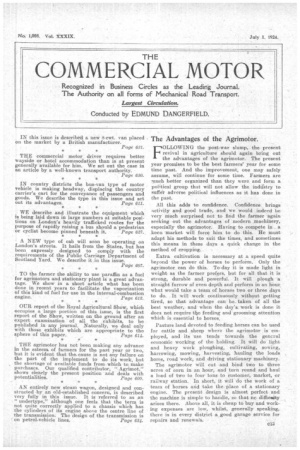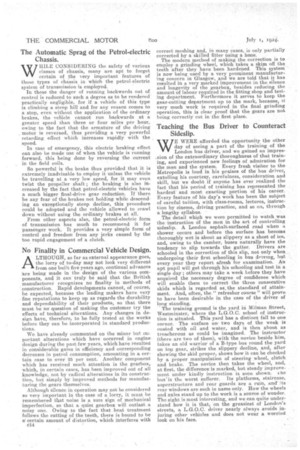The Advantages of the Agrimotor.
Page 1

Page 2

If you've noticed an error in this article please click here to report it so we can fix it.
FOLLOWING the post-war slump, the present revival in agriculture should again bring out the advantages of the agrimotor. The present year promises to be the best farmers' year for some time past. And the improvement, one may safely assume, will continue for some time. Farmers are much better organized than they were and form a political group that will not allow the indif-stry to suffer adverse political influences as it has done in the past.
All this adds to confidence. Confidence brings activity and good trade, and we would indeed be very much surprised not to find the farmer again seeking out the advantages of modern machinery, especially the agrimotor. Having to compete in a keen market will force him to do this. He must adapt his methods to suit the times, and sometimes this means in these days a quick change in the method of cropping.
Extra cultivation is necessary at a speed quite beyond the power of horses to perfoisn. Only the agrimotor can do this. To-day it is made light in weight as the farmer prefers, but for all that it is strong, durable and powerful. It will plough a straight furrow of even depth and perform in an hour what would take a team of horses two or three days to do. It will work continuously without getting tired, so that advantage can be taken of all the best weather, and when the day's work is done it does not require tip feeding and grooming attention which is essential to horses.
Pasture land devoted to feeding horses can be used for cattle and sheep where the agrimotor is employed, and its use tends towards the general economic working of the holding. It will do light and heavy work ploughing, cultivating, sowing, harrowing, mowing, harvesting, hauling the loads home, road work, and driving stationary machinery.
The agrirnotor will cut and bind two to three acres of corn in an hour, and turn round and haul a load of two to four tons to customer, market, or railway station. In short, it will do the work of a team of horses and take the 'place of a stationary engine. The present design is almost perfect and the machine is simple to handle, BO that no difficitelty arises there. Above all, it is cheap to buy and working expenses are low, whilst, generally speaking, there is in every district a good garage service for repairs and renewals.
The Automatic Sprag of the Petrol-electric Chassis.
WHILE CONSIDERING the safety of various classes of chassis, many are apt to forget certain of the very important features of those types of chassis in which the petrol-electric system of transmission is employed. In these the danger of running backwards out of control is reduced to such a degree as to be rendered practically negligible, for if a vehicle of this type is climbing a steep hill and for any reason comes to a stop, even without the application of the ordinary brakes, the vehicle cannot run backwards at a greater speed than three or four miles per hour, owing to the fact that the armature of the driving , motor is reversed, thus providing a very powerful retarding effect which increases rapidly with the speed. In case of emergency, this electric braking effect can also be made use of when the vehicle is running forward, this being done by reversing the current in the field coils.
So powerful is the brake thus provided that it is extremely inadvisable to employ it unless the vehicle be travelling at a very low speed, for, it may even twist the propeller shaft ; the braking is also increased by the fact that petrol-electric vehicles have a much bigger final-drive gear reduction. If there be any fear of the brakes not holding while descending an exceptionally steep decline, this procedure could be adopted and the vehicle allowed to crawl down without using the ordinary brakes at all. From other aspects also, the petrol-electric form of transmission has much to recommend it for passenger work. It provides a very simple form of control and freedom from any jerks caused by the too rapid engagement of a clutch.
No Finality in Commercial Vehicle Design.
ALTHOUGH, so far as external appearance goes, the lorry of to-day may not look very different from one built five years ago, continual advances 'are being made in the design of the various components, and it can truly be said that the British manufacturer recognizes no finality in methods of construction. Rapid developments cannot, a course, be expected, because the leading makers have very fine reputations to keep up as regards the durability and dependability of their products, so that there must be nci question of making the customer try the effects of technical alterations. Any changes in design have, therefore, to be fully tested at the works before they can be incorporated in standard productions.
We have already commented on the minor but 1111portant alterations which have occurred in engine design during the past few years, which have resulted in considerable gains in efficiency and corresponding decreases in petrol consumption, amounting in a certain case to over 25 per cent. Another component which has received much attention is the gearbox, which, in certain cases, has been improved out of all knowledge, not by radical alterations in its construction, but simply by improved methods for manufacturing the gears themselves. Although silence in operation may not be considered so very important in the case of a lorry, it must be remembered that noise is a sure sign of mechanical imperfection, so that a quiet gearbox will outlast a noisy one Owing to the fact that heat treatment follows the cutting of the teeth, there is bound to be a; certain amount of distortion, which interferes with
(114
correct meshing and, in many cases, is only partially corrected by a skilled fitter using a hone. The modern method of making the correction is to employ a grinding wheel, which takes a skim off the teeth after they have been hardened This system is now being used by a very prominent manufacturing concern in Glasgow, and we are told that it has resulted in a very marked improvement in the silence and longevity of the gearbox, besides reducing the amount of labour required in the fitting shop and-testing department. Furthermore it serves to keep the gear-cutting department up to the mark, because, it very much work is required in the final grinding operation, this is clear proof that the gears are not being correctly cut in the first place.
Teaching the Bus Driver to Counteract Sideslip.
WE WERE afforded the opportunity the other day of seeing a part of the training of the London bus driver, and we gained an impression of the extraordinary thoroughness of that training, and experienced new feelings of admiration for
the men and the system. Every fresh visitor to the Metropolis is loud in his praises of the bus driver, extolling his courtesy, carefulness, consideration and
skill, but we doubt if anyone has ever realized the fact that his period of training has represented the hardest and most exacting portion of his career. Every feature of his day's work has been the subject of careful tuition, with class-rooms, lectures, instruction by cinema, driving practice, and so on, through a lengthy syllabus. , The detail which we were permitted to watch was the instruction of the men in the art of controlling sideslip. A London asphalt-surfaced road when a shower occurs and before the surface has become thoroughly wet is about as slippery as a sheet of ice, and, owing to the camber, buses naturally have the tendency to slip towards the gutter. Drivers are schooled in the correction of this slip, not only when undergoing their first schooling in bus driving, hut every year they report afresh for examination. An apt pupil will get through his schooling and test in a single day ; others may take a week before they have acquired the necessary degree of confidence which will enable them to correct the three consecutive skids which is regarded as, the standard of attainment. And, often, the " refresher course" will prove to have been desirable in the case of the driver of long standing. The training ground is the yard in Milman Street, Westminster, where the L.G.O.C. school of instruction is situated. This yard has a distinct fall to one corner. The surface on two days of the week is coated with oil and water, and is then about as treacherous as could be imagined. The instructor (there are two of them), with the novice beside him, takes an old warrior of a B-type bus round the yard on top gear, strikes the slippery decline, and, after showing the skid proper, shows how it can be checked by a proper manipulation of steering wheel, clutch and brake. The novice then takes the wheel, and, at first, the difference is marked, but steady improve ment under kindly instruction ia soon shown. -the bus'is the worst sufferer. Its platforms, staircase, superstructure and rear guards are a ruin, ancr !ts rear windows are such in name only. How the wheels and axles stand up to the work is a source of wonder. The sight is most interesting, and we can quite understand how it is that, on the greasiest of London's streets, a L.G.O.C. driver nearly always avoids injuring other vehicles and does not wear a worried look on his faze.














































